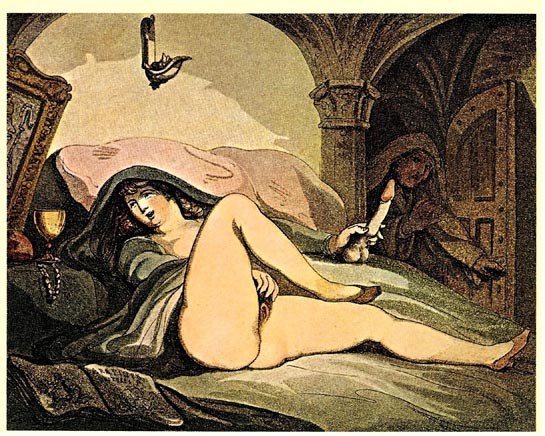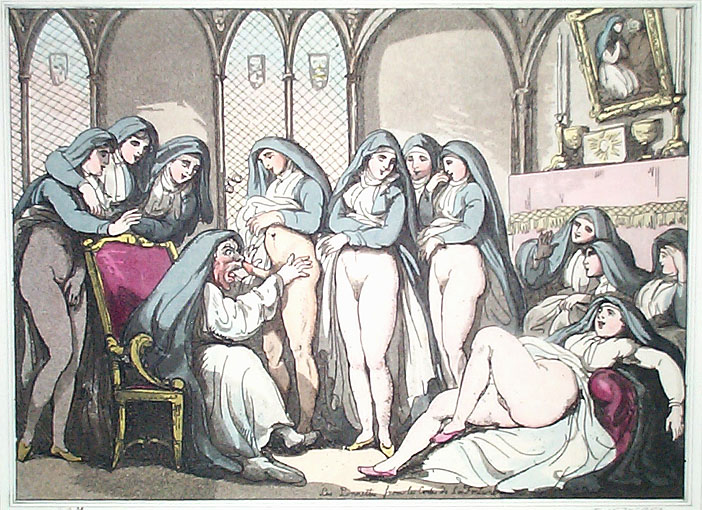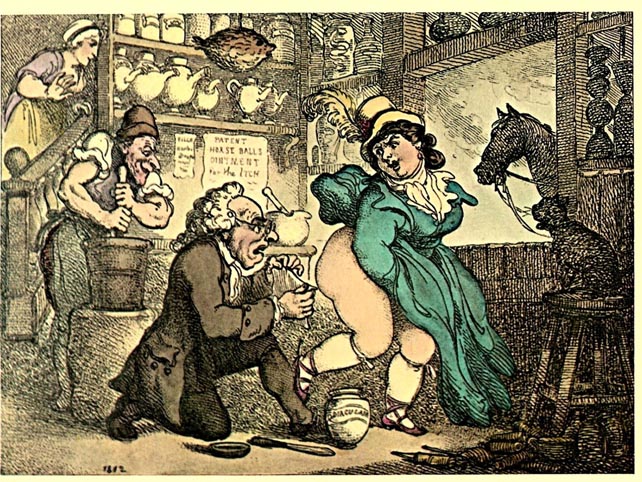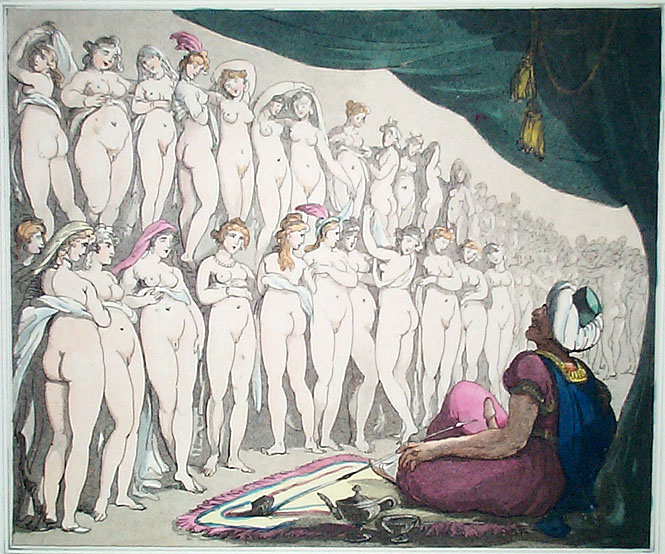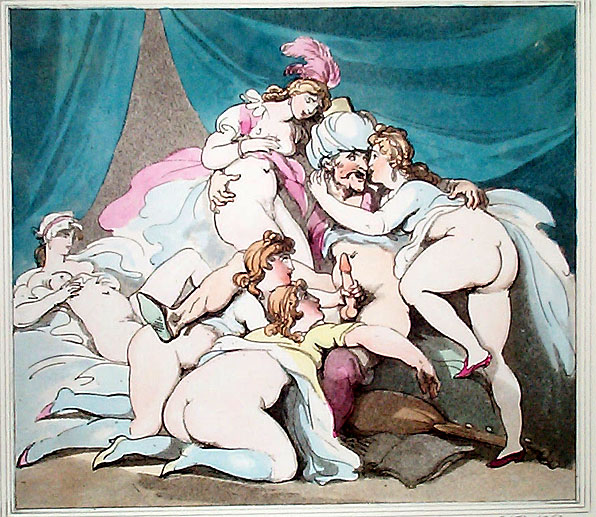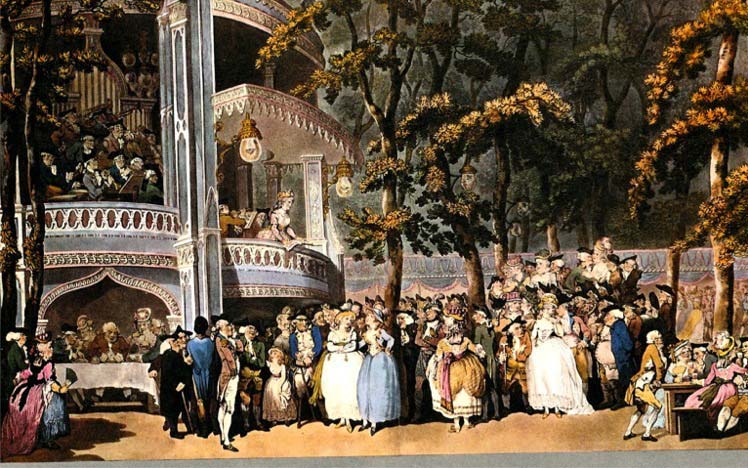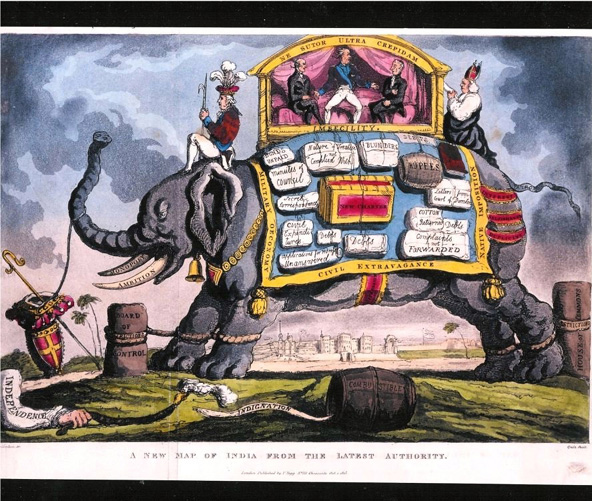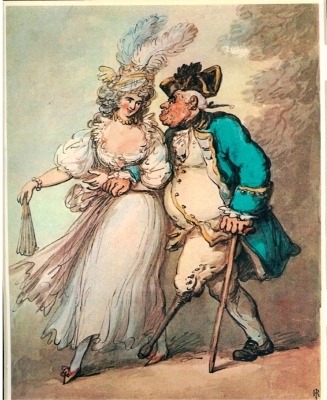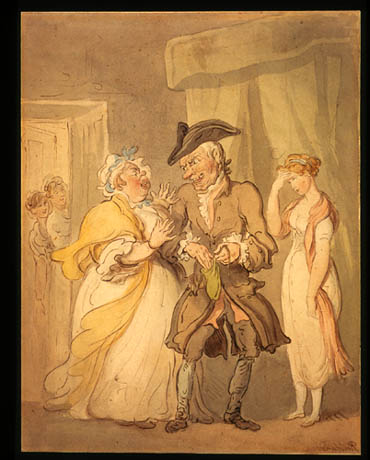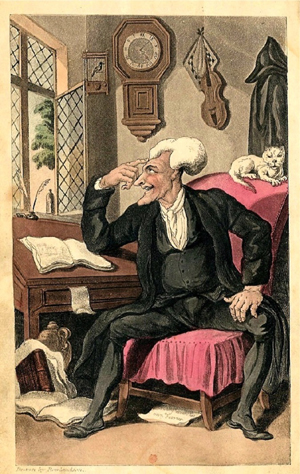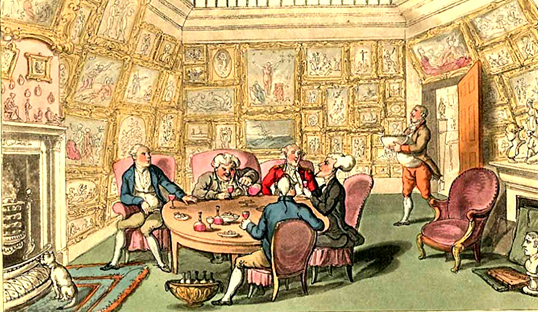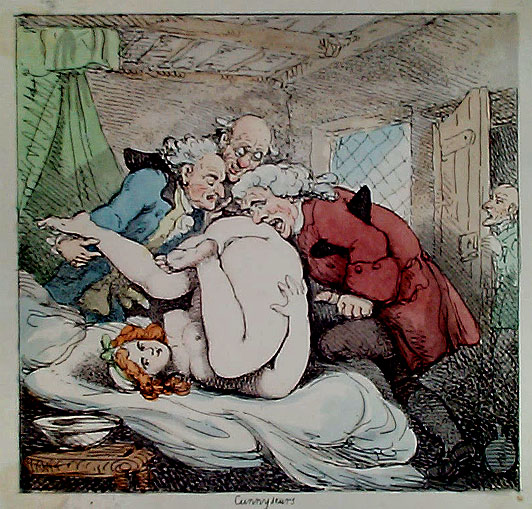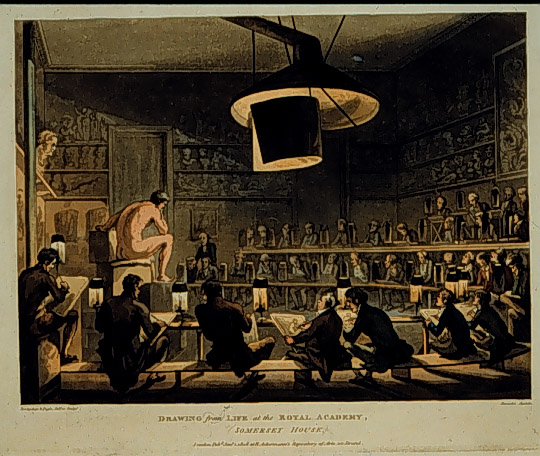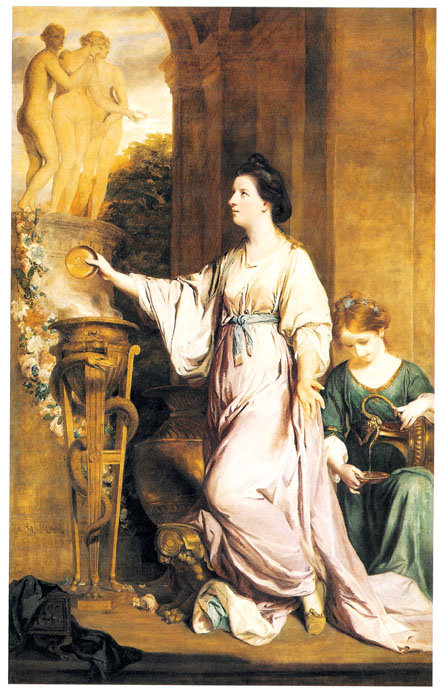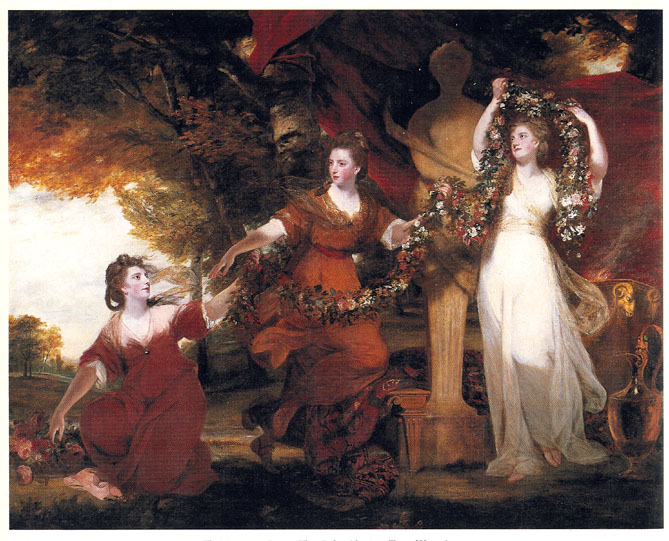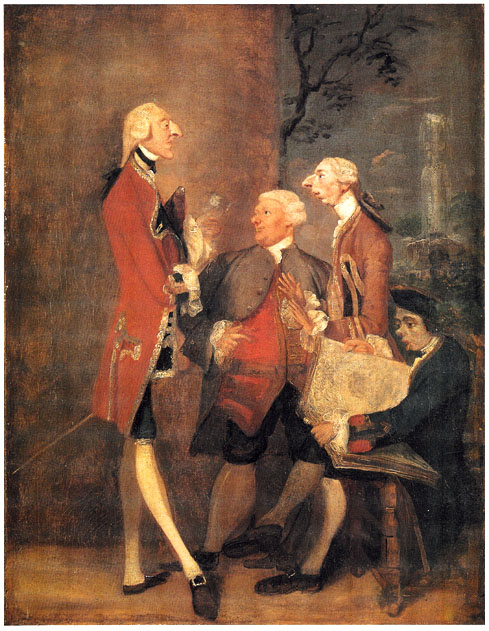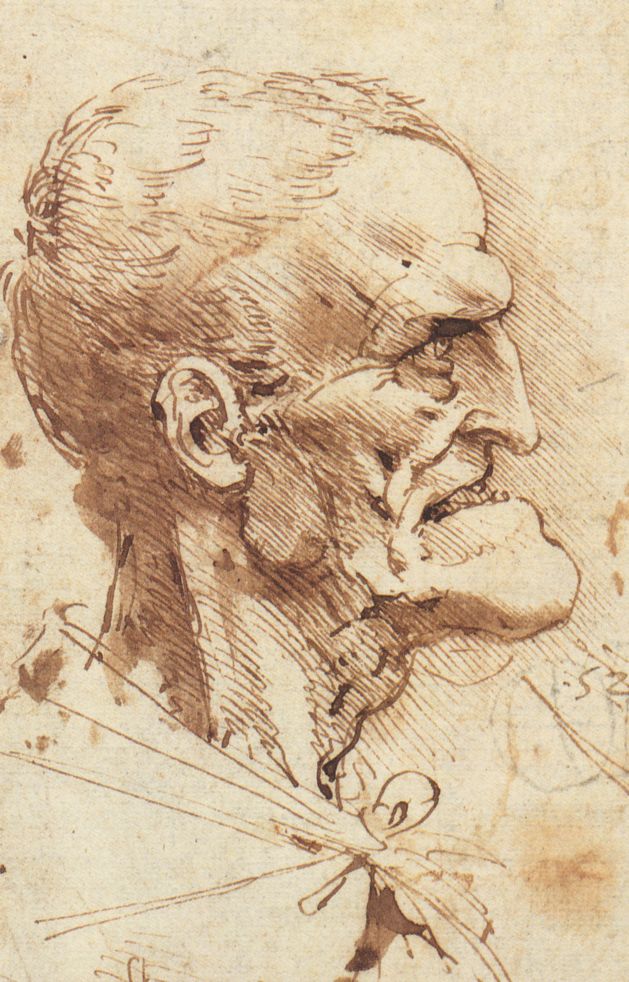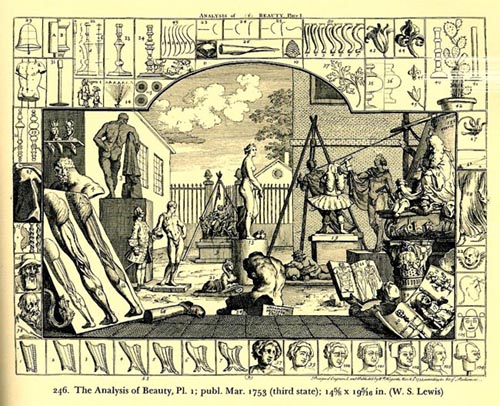Article body
Art is the nearest thing to life: it is a mode of amplifying experience and extending our contact with our fellow-men beyond the bounds of our personal lot. All the more sacred is the task of the artist when he undertakes to paint the life of the People. Falsification here is far more pernicious than in the more artificial aspects of life.
George Eliot, "The Natural History of German Life" [1856]
The connoisseurs and I are at war, you know; and because I hate them, they think I hate Titian, and let them.
William Hogarth to Hester Thrale, in Anecdotes of Samuel Johnson [1786]
I
Consider that well-known passage in Middlemarch (1871) where Eliot describes Lydgate's intellectual epiphany:
. . . one vacation, a wet day sent him to the small home library to hunt once more for a book which might have some freshness for him: in vain! unless, indeed, he took down a dusty row of volumes with grey-paper backs and dingy labels—the volumes of an old Cylopedia which he had never disturbed. It would at least be a novelty to disturb them. They were on the highest shelf, and he stood on a chair to get them down. But he opened the volume which he first took from the shelf . . . . The page he opened on was under the head of Anatomy, and the first passage that drew his eyes was on the valves of the heart. He was not much acquainted with valves of any sort, but he knew the valvae were folding doors, and through this crevice came a sudden light startling him with his first vivid notion of finely-adjusted mechanism in the human frame. A liberal education had of course left him free to read the indecent passages in the school classics, but beyond a general sense of secrecy and obscenity in connection with his internal structure, had left his imagination quite unbiassed, so that for anything he knew his brains lay in small bags at his temples, and he had no more thought of representing to himself how his blood circulated than how paper served instead of gold. But the moment of vocation had come, and before he got down from his chair, the world was made new to him by a presentiment of endless processes filling the vast spaces planked out of his sight by that wordy ignorance which he had supposed to be knowledge. From that hour Lydgate felt the growth of an intellectual passion. [1]
p. 92
Beating close to the thematic heart of the novel, this passage presents a series of artfully managed oppositions: high and low, open and shut, light and dark, seen and unseen, new and old, and—most importantly—known and unknown. The issue is transformation: as the rational mind contemplates the mysteries of its material body, innocence is lost, experience gained, and "intellectual passion" displaces the "wordy ignorance" of "liberal education." The passage is remarkable for that authorial vigor, which, like the organ in question, pumps word after word with daunting precision and purpose. Of particular interest is Eliot's choice of the word "obscene." Again: "A liberal education had of course left him free to read the indecent passages in the school classics, but beyond a general sense of secrecy and obscenity in connection with his internal structure, had left his imagination quite unbiassed, so that for anything he knew his brains lay in small bags at his temples, and he had no more thought of representing to himself how his blood circulated than how paper served instead of gold." From the Greek meaning "off or behind the stage," "obscenity" suggests that which is visually prohibited—because of its violent, coarse, or sexual nature—but that which is indispensable to, if not the cause of, the staged events. In Eliot's rendering, "obscenity" moves outward from the "indecent passages" of classical authors and into human subjectivity. "Obscenity" is then internalized as the unseen but unavoidable physicality of the body, the material precondition of the rational mind. At the moment of epiphany, Lydgate's "unbiassed" imagination dispels the obscene and reconceptualizes the material reality of the body as a series of mysterious but ultimately knowable biological processes.
It matters greatly, of course, that Eliot will correct Lydgate's scientific presumption. When Rosamond's lip trembles and Lydgate succumbs, we are to be aware that he who seeks to know the human heart has just profoundly misread his own. Like his counterpart, Bulstrode, or Casaubon—that poster child of academic dysfunction—Lydgate will repeatedly overestimate his own intellectual power and underestimate the power of the social, political, and economic networks in which he is situated. It matters even more, however, that Middlemarch is most emphatically set in the years immediately preceding the Reform Bill of 1832 and that the novel is itself very much concerned with the cultural transformation that Britain underwent during that period. Eliot carefully provides a detailed and inclusive record of the emergence of a new British social and political identity—a new state "character" if you will. Thus, it is no accident that Lydgate's intellectual epiphany coincides historically with the emergence of modern scientific discourse. [2] As Marilyn Gaull points out in her useful history, English Romanticism, 1831 saw the formation of The British Association for the Advancement of Science and thus serves as a convenient date from which to mark the end of the old scientific "populism" and the beginning—institutionally, discursively, and ideologically—of a new scientific "professionalism." [3] That professionalism, much like Lydgate himself, presumptuously challenged traditional pieties as it established new standards against which to measure the production and consumption of scientific knowledge.
Coincidentally or not—and I believe not—the late 1820s and early 1830s also witnessed the emergence of another discourse of paramount interest to the modern state: pornography. Unlike obscenity, its larger and more inclusive discursive parent, "pornography" is a nineteenth-century neologism, and it refers specifically to graphic images or narratives that have been mass-produced for the sexual use of their consumers. [4] Art historians and bibliographers might be quick to object to my chronology—with the former arguing that visual depictions of human sexuality in western culture are as old as Pompeii, and the latter arguing that Aretino's Ragionamenti, Chorier's Satyra sotadica, and Barrin's Venus dans la cloitre appeared in 1534, 1660, and 1683 respectively. But recent scholarship suggests the following: although we have numerous examples in Britain of sexually explicit literature and art before 1800, the function of that material was not exclusively to arouse the audience, nor was it mass-marketed for commercial gain by authors, printers, and publishers who understood and presupposed its "illegitimate" pleasures. [5] More accurately termed "proto-pornographic," this material may have included sexually explicit scenes, but those scenes were at the time experimental: they were exploring the edges of that always troublesome boundary between legitimate and illegitimate representational pleasure. Before 1800, in other words—and Fanny Hill (1749) notwithstanding—"pornography" simply did not exist as a recognizable generic category; on the contrary, it was discursively entangled among other closely related genres and sub-genres. Sensational romances, scandal novels, bawdy poems and stories, whore dialogues and rogue biographies, pseudo-medical manuals, political exposes, and anti-ecclesiastical tracts all made use of "pornographic" strategies and techniques. But without a clearly defined discursive terrain of its own, without clear-cut generic boundaries and stable readerly and authorial expectations, those strategies and techniques were hard to distinguish from other kinds of obscene writing. In short, pornography as we know it emerged over the course of the eighteenth century, not in any kind of smooth evolutionary progression, but instead by fits and starts and according to a logic peculiarly its own. By 1820, the year of Queen's Caroline trial for adultery, pornography had become a popular sub-genre of political invective. In the years after the trial, as Iain McCalman has convincingly argued, a significant number of radical pressmen gave up political pamphleteering and, for a variety of reasons (not the least of which was profit), began trafficking in a new kind of obscene narrative. By 1830, pornography, as we have come to understand it, was a flourishing, if disreputable, British industry.
I will argue that the emergence of pornography in the late 1820s and early 1830s is as important to Eliot's passage, and by extension to the nascent modernity Middlemarch depicts, as the scientific curiosity to which that passage directly refers. At issue is the way in which different discourses at once know and represent their objects of inquiry: in the case of medical science, the material reality of the human body; in the case of pornography, the psychology and physiology of sexual pleasure. No less important are those larger narratives in which Lydgate's passage is embedded—history and literature—and their respective claims to know and represent past events and human experience. In order to understand more fully what is at stake in this discursive intersection, I would like to turn to the work of a well-known but under-appreciated British artist and printmaker—Thomas Rowlandson—with the hope that his remarkable career might shed light upon the emergence of the pornographic imagination. Specifically, I will consider a representative number of Rowlandson's sexually explicit prints and argue that his obscene satire was inextricably rooted in the aesthetic debates of his day and that his so-called "pornographic" prints and drawings participate in a carefully delineated rejection of elite culture.
II
Thomas Rowlandson was hardly the first British artist to produce graphic representations of sexual subjects. He was, however, one of the first British artists to mass produce sexually explicit material whose intent appears more to amuse and titillate than to instruct, illustrate, vilify, or satirize. Obscenity in service of the latter was of course common throughout the romantic period, as it had been throughout much of the eighteenth century. Political caricatures—the word "cartoon" was not used in the modern sense until the middle of the nineteenth century—had made frequent use of obscene material for the purposes of vilification. This Rowlandson print from the 1784 Westminster election, entitled Political Affection, is typical (fig. 1. Affection). It depicts Charles James Fox nursing at the breast of the Duchess of Devonshire and so capitalizes nicely both on her political patronage of the Whigs and on her practice—scandalous at the time—of breast-feeding her children. The portrait on the left is a sketch of Sir Joshua Reynolds's portrait of the Duke of Devonshire, while the composition itself is taken rather boldly from Rubens's Cimon and Pero (1635) (fig. 2. Rubens). Rowlandson's political message—Fox's infantile and incestuous dependence upon the Duchess—is thus nicely situated between two allusions, one to a work by the premiere portrait painter of the day and the other to a well-known and highly sensational history painting. It is a triangulated relationship in which Rowlandson's political caricature—"obscene" though it may be—emerges possessing a different and more effective verisimilitude.
Figure 1
Figure 2
Like political caricature, book illustrations were also known to cross the line into the clearly disreputable. Whenever there was a book of questionable character or lewd intent, suitable illustrations followed not long behind. These three illustrations are all from Jean Barrin's 1683 Venus in the Cloister, made famous by Edmund Curll's 1724 translation and illustrated by Rowlandson sometime in the first decade of the nineteenth century (fig. 3. Timely) (fig. 4. lunettes) (fig. 5. Grate). The first print, The Timely Visit, depicts the book's opening scene, in which, with dildo in hand and Aretino's Postures open in the lower left corner, the masturbating Agnes is caught by Angelica. In addition to providing the predictable tension between natural indulgence and religious repression, the drawing asks its viewers to contemplate the relationship between real sexual pleasure and its fictional representation. Aretino's text, itself a composite of poems and illustrations, provides the necessary fantasy for the real pleasure of a fictional character in a drawing self-conscious about its own role as sexual prop. The second print, Les lunettes, makes explicit the anti-ecclesiastical humor implicit in the first. Seeking to unmask the male interloper in her midst, the Prioress pries apart the thighs of the "nun" before her only to have his erect penis slap the glasses from her face. That erect penis, like the forces of nature generally, will not be constrained physically, theologically, or artistically. The third print, untitled, is more Rowlandson than Barrin, more late romantic than late seventeenth century, more "pornographic" than "obscene." In it, sexual intercourse is represented not implied, and satiric humor has given way to a "pornographic" transgression.
Figure 3
Figure 4
Figure 5
Social satire was of course the larger, more inclusive generic category, and, like both political cartoons and book illustrations, it also made frequent use of obscenity. The majority of Rowlandson's sexually explicit works are first and foremost satiric, for even though exposed genitalia and active intercourse are commonplace, such depictions often serve ends more humorous than "pornographic." In this print, for example, Family on a Journey Laying the Dust, the target is genteel modesty (fig. 6. Dust). Rowlandson's purpose is similarly comedic in both The Ride to Rumford and The Jugglers (fig. 7. Rumford) (fig. 8. Jugglers). Other prints, however, leave satire behind and approach what the modern viewer is more likely to term the "pornographic." In so doing, they amplify the tension we noted earlier in the illustrations to Venus in the Cloister. In Lonesome Pleasures, for example, the solitary pleasure seeker seems either a product of or a vehicle for male fanatasy (fig. 9. Lonesome). The effect is similar in two eastern prints, The Harem and The Pasha (fig. 10. Harem) (fig. 11. Pasha). The interpretive challenge here—how does one properly differentiate the pornographic from the satiric?—quickly becomes inextricable from a series of larger historical and critical problems: Did the pornographic imagination in the visual arts emerge from the satiric? If so, when? Under what conditions? Is Rowlandson's work representative of a key shift in the cultural marketplace? How much do we actually know about the ways in which these prints were circulated? Can we better approximate how these prints functioned during the later Romantic period? I will argue that Rowlandson's work is representative of a crucial shift in the cultural marketplace and that modern pornography has its roots in an oppositional satire whose obscenity worked in philosophical contradistinction to the aesthetic pieties of the time.
Figure 6
Figure 7
Figure 8
Figure 9
Figure 10
Figure 11
Rowlandson's sexually explicit prints are well-known to scholars of British Romanticism. Many were originally part of George IV's collection at Windsor Castle, and they are now scattered among various public institutions—the Library of Congress, the British Museum, the Victoria and Albert Museum, to name a few—and in private collections in this country and abroad. A significant number of these prints have been reproduced and are currently available in two book-length collections, Gert Schiff's The Amorous Illustrations of Thomas Rowlandson (1969) and Kurt von Meier's The Forbidden Erotica of Thomas Rowlandson (1970), neither of which provides appropriate information either about individual prints or about the environment in which the prints originally appeared. [6] The result, however inadvertent, is that Rowlandson's work loses its historical specificity and is transformed by editorial fiat into the "amorous illustrations" or "forbidden erotica"of the title-page. Modern readers are thus asked to create a kind of "pornography" of which they themselves are the source. Scholarship has provided little assistance. From the obituary that appeared in The Gentleman's Magazine in 1827, through all of those scholarly efforts by Joseph Grego, A. P. Oppe, Bernard Falk, Arthur Heintzelman, John Hayes, Robert Wark, John Riely, and Ronald Paulson, to the most recent books and articles, the details of history and biography yield time and again to scholarly speculation—occasionally informed, occasionally not. [7] We have, after all, only three of Rowlandson's own letters and only a handful of contemporary accounts of his colorful life. [8] On the other hand, we also have more than ten thousand drawings and prints in museums and libraries and private collections across the world. There is no other Romantic figure from whom we have so much and about whom we know so little.
For art historians, Rowlandson remains a marginal figure. Trained at the Royal Academy—he was on the books from 1772 until 1778—Rowlandson exhibited regularly for a decade before renouncing Academy Exhibitions for more the varied venues of commercial art. Although he continued throughout his life to produce stunning watercolor landscapes, portraits, and street scenes, he also produced vast numbers of prints: as we have seen, he did political cartoons, social satires, caricatures, book illustrations, and several varieties of proto-pornography. Art historians are quick to remember the large watercolors of the 1780s—Vauxhall Gardens (1784), Skaters on the Serpentine (1784), and The English and French Reviews (1786). Of these, Vauxhall Gardens is perhaps his most famous work, and its appearance at the Royal Academy Exhibition in 1784 was considered scandalous (fig. 12. Vauxhall). The Prince of Wales and his mistress appear on the right, the Duchess of Devonshire and her sister just left of center, and Johnson and Boswell on the left. Rowlandson's choice of watercolor, his contemporary subject matter, and his irreverent penchant for caricature ensured that Vauxhall Gardens and his other exhibition watercolors would take their place as comedic footnotes to the grander narratives of Reynolds, West, Girtin, Haydon, Turner, Martin, and Constable. Rowlandson's name appears more frequently in discussions of satire. There he is mentioned with Gillray, Cruikshank, and Newton as one of the spirited Romantic descendants of William Hogarth. [9] Although he produced significantly fewer political caricatures than either Cruikshank or Gillray, Rowlandson clearly made his mark. The British Museum's Catalogue of Political and Personal Satires lists well more than five hundred caricatures between 1775 and 1820. The Westminster Election of 1784, the Regency crisis of 1788-89, the French Revolution, the Mary Ann Clarke scandal of 1809, and the Napoleonic Wars are all well represented. In this 1813 cartoon, Rowlandson attacks the East India Company (fig. 13. India). On the left in the foreground, a white-shirted arm labeled "Independence" lights the fuse of "Indignation" to the powder keg on which we can barely read the words "Combustible Vox Populi." In a satire of a very different order from 1811, we see the dons of Brasenose College, Oxford, subjected to the artist's ire. Here, too, there is a political angle, however oblique, in that Oxford was at the time, a thoroughly Tory institution and one Rowlandson delighted to ridicule (fig. 14. Bacon). The caption reads: "Bacon Faced Fellows of Brazen Nose, Broke Loose." Of course, Rowlandson's targets were many. Here is Mrs. Siddons rehearsing (fig. 15. Siddons). Here "A French Frigate Towing an English Man O'War into Port" (fig. 16. Frigate). Here "Innocence in Danger" (fig. 17. Innocence). All of the above were printed and reprinted and were available as individual prints or as part of collections like the Hudibrastic Mirror (fig. 18. Mirror). Such collections were popular and easily available for sale or let at caricature shops across the city. Rowlandson's more obscene work had, most likely, a very different mode of circulation.
Figure 12
Figure 13
Figure 14
Figure 15
Figure 16
Figure 17
Figure 18
If art historians remember a marginal figure who his squandered his talent in the popular marketplace, literary historians are likely to remember Rowlandson for his book illustrations. In the early 1790s, he illustrated Smollett and Fielding. Later he would also do Shakespeare and Sterne and Goldsmith. Rowlandson worked intermittently for Thomas Tegg and Rudolph Ackermann before collaborating on the 1806 Microcosm of London, an Ackermann project that was hugely successful and brought Rowlandson in contact with hack writer and poet William Combe. Combe and Rowlandson would together produce The Three Tours of Dr. Syntax, the first volume in 1812 and two others in 1820 and 1821. Rowlandson's thirty-two aquatint illustrations to that first volume and his timely parody of William Gilpin and the pursuit of the picturesque made Dr. Syntax a smashing success [10] (fig. 19. Frontispiece) (fig. 20. Lord). This collaboration between poet and illustrator was unusual in that Rowlandson was in control: he produced the drawings first and sent them one or two at a time to Combe who would then compose the verses to go with the drawings. This was the same process that Rowlandson and Combe followed when they produced their other popular series, The English Dance of Death, the first volume of which appeared in 1815, the second in 1816.
Figure 19
Figure 20
Dr. Syntax notwithstanding, Rowlandson's power as an artist was not limited to his trumping of verbal narrative. To the contrary, in many of his drawings and almost all of his caricatures, he made strategic use of language and resisted purely visual images. I believe that Rowlandson's work self-consciously reacts against the aesthetic isolation of purely visual high art by foregrounding satiric captions and verbal clues in an attempt both to maximize his satiric humor and—more importantly—to draw attention to his own unique place in the cultural marketplace. [11] Consider, for example, Rowlandson's The Man of Feeling, a print I have discussed at length elsewhere [12] (fig. 21. Feeling). With John Wilkes's "An Essay on Woman" protruding from his pocket and a church—presumably his own—distinctly visible in the background, the parson has his hand strategically placed in the bosom of his companion. Without its title, however, The Man of Feeling would be just another jab at religious hypocrisy, just another lascivious cleric preaching one thing and doing another. But Rowlandson's title is also the title of Henry Mackenzie's popular 1771 novel. Rowlandson, therefore, makes a wonderful play on the word "feeling": the "feeling" in his print is physically real—hand to breast, skin to skin—and as such, it becomes a materialistic corrective to the "feeling" of sensibility. Equally important is the presence of Wilkes's "An Essay on Woman" (1763). An obscene parody of Pope's "An Essay on Man," Wilkes's poem became well-known when its author was expelled from the House of Commons and his periodical, The North Briton, suppressed. In his poem, Wilkes uses words like "fuck" and "prick" to violate literary decorum in such a way that wreaks havoc with Pope's philosophical assumptions: Pope was an idealist who began his philosophical enterprise with certain knowledge of God's perfection, while Wilkes was a materialist who began with the physical reality, and the obvious imperfection, of the body. First Pope:
ll. 1-8Awake, my St John! Leave all meaner things
To low ambition, and the pride of Kings.
Let us (since Life can little more supply
Than just to look about us and to die)
Expatiate free o'er all this scene of Man;
A mighty maze! But not without a plan;
A Wild, where weeds and flow'rs promiscuous shoot,
Or Garden, tempting with forbidden fruit.
Now Wilkes:
ll. 1-8Awake, my Fanny, leave all meaner things;
This morn shall prove what rapture swiving brings!
Let us (since life can little more supply
Than just a few good fucks, and then we die)
Expatiate free o'er that loved scene of man,
A mighty maze, for mighty pricks to scan;
A wild, where Paphian Thorns promiscuous shoot,
Where flowers the Monthly Rose, but yields no Fruit.
In Pope's revision of Milton, "this scene of Man" becomes a new Eden, "A mighty maze" whose "plan" will be mapped out by the Godlike poet. In Wilkes's parody, "the loved scene of man" becomes female genitalia that the poet must "explore" in order to understand "how Nature works." The central action of Rowlandson's print—the transgressing hand of the bemused parson—is thus situated neatly between two "literary" references: the first to the sublimated passions of sensibility; the second to the bawdy realism of obscenity. As a result, The Man of Feeling becomes more a meditation on the nature of representation and the truth and falsity of that which it represents than just another attack upon religious hypocrisy. Like Political Affection, which jokingly displaced both of the elite works to which it referred, The Man of Feeling offers itself as a corrective to the representations of high art, whose pleasures, Rowlandson insists, are unavoidably corporeal. The perfect medium for this message was the print. Mass-produced, inexpensive, educated but not pretentious, and above all witty, the satiric print had nothing to lose and nothing to fear.
Figure 21
Consider another of Rowlandson's prints, The Connoisseurs, the title of which once again speaks volumes (fig. 22. Connoisseurs). As did The Man of Feeling, The Connoisseurs plays with the epistemological problematics of aesthetic pleasure by highlighting the degree to which highbrow fictions are themselves mediated by sexual experience. In other words, Rowlandson's treatment of the lecherous connoisseurs ridicules at once the supposed disinterestedness of high art and the pseudo-objectivity of the critic. His particular target is the nude: no matter how ornate the frame or well-dressed the viewer, both canvas and connoisseur share the pleasures of the body, not the transhistorical truth of ideal beauty that body is said to represent. The canvas masquerades the sexual as the aesthetic, and the connoisseurs follow suit. Rowlandson laughs at both, and in so doing challenges the well-policed boundary between high and low art as well as the sanctimonious elitism that prevents the former from being sullied by the latter. Once again, the joke has an obvious generic dimension: Rowlandson's audience would have been well aware that the pretensions of oil painting were being satirized by a cheap, hand-colored etching. They would have also been aware that Rowlandson was following closely in the footsteps of Hogarth whose battles with the connoisseurs of his day were legion.
Figure 22
Among the numerous versions of The Connoisseurs—and there are many—is a print in which the centrally located canvas has been replaced by a woman who, with neck and shoulders on the ground and posterior high in the air, offers her genitals for the inspection of three most interested gentleman (fig. 23. Cunnyseurs). Rowlandson's title, The Cunnyseurs, extends the obvious satire by replacing the root of "connoisseur"—the French verb "connaitre," to know—with the British slang for female genitalia. The title also insists that the two drawings, the good-natured satire and its obscene counterpart, be taken together as a single meditation upon aesthetic pleasure. If the former sexualizes aesthetics, then the latter aestheticizes sexuality. The gilded gallery gives way to the bedroom of the bordello as one kind of prostitution illuminates another and as one male gaze qualifies another. At the same time, the body of oil and pigment is placed in reciprocal relation to another of flesh and blood. The latter is of interest only at its genital center, a body reduced to a fetish of male fantasy. Where exactly, Rowlandson muses, are we to find the "real" site of pleasure? Is it within the conventional nude, de-corporealized by the sublimated "taste" of the connoisseur, or at the whore's "cunny," the objectified Holy Grail of male desire? How are we to know the difference? Should we trust the connoisseur's educated eye or the lecher's prurient gaze? the expensive oil painting or the cheap, crudely colored print?
Figure 23
A much later aquatint situates this problematic within an institutional setting (fig. 24. RAs). Modeled closely upon the Drawing from Life at the Royal Academy print included in Ackermann's Microcosm of London (1806-11), this 1824 print changes the male model for a female, substitutes specific portraits for generalized figures, and identifies the portraits with initials (fig. 25. Microcosm). There is also—characteristically—a caption: "RA's of Genius reflecting on the true line of Beauty at the Life Academy Somerset House." Gone are the generic figures and good-natured bemusement of The Connoisseurs. Gone too is the respectful distance and formality of the Microcosm print. By 1824, both humor and respect have been replaced by specificity and allusion. The caption, the careful portraits, and the visible initials all serve to identify the individual and collective targets of the artist's satire. Benjamin West and Thomas Laurence and Martin Archer Shee look on from the left, Benjamin Haydon from the right, Joseph Farrington and Richard Westall from the center back. [13] The statues and busts in the background serve to emphasize the voyeurism of the scene: they are ghostlike spectators who call attention to the pleasures of watching but who also suggest a more fluid connection between real bodies and their representations. In Rowlandson's print, art watches as human beings, or representations thereof, make art out of another human being. It is a Pygmalion myth of sorts, and Rowlandson is perfectly aware of the epistemological Mobius strip he has created.
Figure 24
Figure 25
The caption provides a crucial gloss on the print and valuable clues about Rowlandson's oppositional aesthetic. The words "Genius" and "true" and "Beauty" are asked to shoulder a heavy ironic burden, and we are to understand that the assembled "Geniuses," like their connoisseur counterparts, disguise sexual pleasure beneath the mask of a disinterested aesthetic curiosity. In an earlier print, for example, entitled The Chamber of Genius (1812), Rowlandson had revisited Hogarth's Distressed Poet in order to emphasize the class conflict at work in the art world (fig. 26. Genius). As his caption points out, impoverished "Genius" is too often "Ridicule[d]" by the "wealthy Fool." Artistic merit, in other words, should not be adjudicated only by the rich. In the caption to the RA's of Genius, the phrase, "the true line of Beauty," also evokes the aesthetic debates of the day while referring unequivocally to William Hogarth's Analysis of Beauty (1753), Sir Joshua Reynolds's Discourses (1770-90), and to the model who poses before the gathered artists. The central action of Rowlandson's print—drawing the nude from life—thus becomes part of a carefully constructed meditation upon the artistic imagination and upon the cultural marketplace within which that imagination functioned. A closer examination of the tensions between Hogarth and Reynolds will help to situate Rowlandson's oppositional aesthetic in relation to larger tensions between popular and elite art.
Figure 26
III
It is hardly a fortuity that Rowlandson's RAs of Genius brings Hogarth and Reynolds together. Between them, the two artists represent a variety of conflicts endemic to the theory and practice of eighteenth-century art. Hogarth, equal parts artist and entrepreneur, elevated engraving to the level of fine art as he proved himself a stubborn champion of an authentically "English" style aware of but unintimidated by continental predecessors. Reynolds, on the other hand, while similarly successful in the marketplace, was, unlike Hogarth, contemptuous of the general public and committed to a formal academy, aristocratic in nature and derived from the French. As Ronald Paulson describes it,
Hogarth's position at this point [the period between Industry and Idleness (1747) and The Stages of Cruelty (1751)] is illuminated by the antithetical position taken by the young Reynolds, who was soon to make his spectacular London debut (1753). Reynolds, returning from Italy, sought to join English art to the great tradition of continental art and to raise the artist to the level of the aristocracy in literacy, social bearing, and public status. Hogarth, although he never hesitated to draw upon the continental tradition himself, rigorously maintained the spiritual separateness of English art and the need for a native tradition: the artist should be unequivocally middle class and his art should be his own. [14]
Contemptuous of connoisseurs and their pretensions, Hogarth was an unrepentant original destined to remain outside the main stream of British art. Regardless of his commercial success, or perhaps because of it, he was identified by Romantic artists and critics with a low and vulgar style that high art would be off without. Henri Fuseli, for example, following Reynolds, expressed relief that the Royal Academicians had by 1801 avoided the "contaminated descent" of Hogarth whose
representations of local manners and national modifications of society, whose characteristic discrimination and humerous exuberance . . . we admire . . . but which like the fleeting passions of the day, everything contributes something to obliterate, which soon after becoming intelligible by time, or degenerate into caricature, the chronicle of scandal, the history book of the vulgar. [15]
Fuseli acknowledges an "exuberance" only to dismiss in its entirety the larger generic category within which that exuberance functions. Hogarth's humor and passion "degenerate into caricature," the lowest of the low, "the chronicle of scandal, the history book of the vulgar." For Fuseli, passion and popularity go hand in hand, and they are both to be studiously avoided.
Hogarth was perfectly aware of his generic choices and the degree to which he could or could not appeal directly to the public. In his memoirs, he explains that his decision to pursue a "popular" audience was made for him by a patronage system unwilling to act for the greater good:
But as religion, the great promoter of this style [i.e., history painting] in other countries, rejected it in England, I was unwilling to sink into a portrait manufacturer; and, still ambitious of being singular, dropped all expectations of advantage from that source, and returned to the pursuit of my former dealings with the public at large. This I found was most likely to answer my purpose, provided I could strike the passions, and by small sums from many, by the sale of prints, which I could engrave from my own pictures, thus secure my property to myself. [16]
However self-serving his hindsight, Hogarth surprises us here with a triangulated relationship between history painting, portraiture, and prints in which prints alone allow the "ambitious" artist direct access to the public, freedom to "strike the passions," and control of property rights. Seeking "small sums from many," Hogarth rejects the epic and the monumental in favor of the cheap and prolific. Passion and popularity translate into freedom and control.
Reynolds could not have followed a more different path. The first president of the Royal Academy espoused the virtues of the historic and poetic, but he made his living painting portraits. He had studied in Italy and tried his hand at caricature (fig. 27. Milords). He then returned to London and produced several showcase portraits that established his reputation (fig. 28. Keppel). In the process, he earned the patronage of Augustus Keppel, the friendship of Samuel Johnson and Edmund Burke, and then, in 1769, the presidency of the newly formed Royal Academy. At the height of his career, he labored in his Discourses and in his painting to meld portraiture more fully to the historic and poetic. His mastery of the traditional—as in this 1774 portrait of Giuseppe Baretti (fig. 29. Baretti)—combined with his occasional excursions into the historic and the poetic—represented here by the famous 1788 The Infant Hercules (fig. 30. Infant)—to create a style of portraiture that made Reynolds famous and distinguished his work from that of Gainsborough and Barry. Garrick between Tragedy and Comedy (1762), (fig. 31. Garrick) Lady Bunbury Sacrificing to the Graces (1765), (fig. 32. Bunbury) and Mrs. Hale as 'Euphrosyne' (1766) (fig. 33. Hale) are three early and well-known examples of what Reynolds himself termed "the great style." [17] Even more famous is his portrait of the Montgomery sisters, Three Ladies Adoring a Term of Hymen (1774) (fig. 34. Montgomery).
Figure 27
Figure 28
Figure 29
Figure 30
Figure 31
Figure 32
Figure 33
Figure 34
Fuseli was grateful to Reynolds for preserving monumental portraiture from Hogarthian caricature. Caricature is portraiture from the other side, as old as the pencil itself but iconoclastic not idolatrous, topical and transitory not monumental and transcendent. Reynolds's uninspired attempt, Milordi, reminds us that the roots of caricature are Italian (fig. 35. Milordi). Sir Joshua alters the faces and figures of his four subjects so that they speak the proper idiom—exaggeration, hyperbole—but he retains both the medium—oil paint—and the setting—the realistic interior space—typical of high portraiture. The hybrid cannot but disappoint. Leonardo's Study # 1, on the other hand, demonstrates both the density of line typical of caricature and its propensity to push the real against the faultline of improbability (fig. 36. Leonardo)In Study #2, the grouped figures intensify the density of line common to each and create a small constellation of highly focused, overly determined subjects (fig. 37. Leonardo). The details, so particular and exacting, insist upon an historical, temporal specificity even as the exaggerated features and grouped portrait push subjectivity from the one to the many, from the individual to the collective. Historical specificity and plural subjectivity provide the cornerstones of caricature. Hogarth proves a case in point. In Characters and Caricaturas (1743), we move from three dimensions to two as the single subject is multiplied past the small group into a taxonomy (fig. 38. Characters). There are only heads, no bodies, no clues from somatotype or dress to distract from the markers of countenance. The countenance, that most significant locus of identity, is no longer permitted—as in monumental portraiture—to define the solitary focal point. Instead, the composition has multiple points of entry, and the viewer is forced into reciprocal dislocation, moving back and forth, between and among the various possibilities. This principle is also at work in both The Company of Undertakers (1737) (fig. 39. Undertakers) and, even more brilliantly, in The Five Orders of Perriwigs (1761) (fig. 40. Perriwigs). In the first, the individual has been subsumed by a type and in the second by an accouterment of fashion. No longer majestic and omnipotent, the self is entirely a social construct, created by profession or style of wig. In both prints, the viewer's attempt to master the composition is further complicated by the inscriptions, by the commentary upon the images, which, like the multiple points of entry, defeats prompt assessment and forces the viewer into actively decoding a message not reverential and idolatrous, but irreverent and iconoclastic, passionate and popular.
Figure 35
Figure 36
Figure 37
Figure 38
Figure 39
Figure 40
Hogarth's Analysis of Beauty is, as Ronald Paulson has repeatedly argued, a central text in the evolution of eighteenth-century aesthetics and one that sheds much light on the politics of visual pleasure at mid-century. [18] Not only does Rowlandson refer directly to the Analysis in RAs of Genius, and not only does he become a standard bearer for Hogarthian sensibilities during a period openly hostile to Hogarth, but he also extends those sensibilities into the patently obscene and eventually into what will become the pornographic. In the Analysis, Hogarth argued for "one precise line, properly to be called the line of beauty" whose serpentine curve derived not from the abstract ideal of truth but from the human body. [19] "I shall endeavour to shew," Hogarth writes in the introduction,
what principles are in nature, by which we are directed to call the forms of some bodies beautiful, others ugly; some graceful, and others the reverse; by considering more minutely than has hitherto been done, the nature of those lines, and their different combination, which serve to raise in the mind the ideas of all the variety of forms imaginable.
p. 1
By emphasizing the primacy of the human body and the variety of nature, Hogarth realizes that he is assuming a decidedly "[un]fashionable" position:
I must confess, I have but little hopes of having a favourable attention given to my design in general, by those who have already had a more fashionable introduction into the mysteries of the arts of painting and sculpture. Much less do I expect, or in truth desire, the countenance of that set of people, who have an interest in exploding any kind of doctrine, that may teach us to see with our own eyes.
p. 2
Opposed to finding beauty through imitation, through the mechanical copying of another's work, Hogarth encourages students of art to look at nature " with [their] own eyes." There they will find that beauty resides most clearly in the female form:
There is an elegant degree of plumpness to the skin of the softer sex, that occasions these delicate dumplings in all their other joints, as well as these of the fingers; which so perfectly distinguishes them from those even of a graceful man; and which, assisted by the more soften'd shapes of muscles underneath, presents to the eye all the varieties in the whole figure of the body, with gentler and fewer parts more sweetly connected together, and with such a fine simplicity as will always give the turn of the female frame, represented in the Venus, the preference to that of Apollo.
p. 66
They will discover as well that nature remains superior to the art that represents her. Considering that oft debated rivalry between the ancients and the moderns, Hogarth finds the "real" third term:
. . . nor would we have it thought, that either of them [ancients or moderns] have ever yet come up to the utmost beauty of nature. Who but a bigot, even to the antiques, will say that he has not seen faces and necks, hands and arms in living women, that even the Grecian Venus doth but coarsely imitate?
p. 66
As Hogarth's aggressive rhetoric makes clear, he believed that only fools would prefer cold marble to living flesh and blood.
The primacy of "living women" to Hogarth's theory of aesthetic beauty is confirmed by the two plates that accompany The Analysis. In the first, Venus is positioned in the exact center of the print (fig. 41. Beauty1). Although not visually dominant in the crowded field, she provides the point from which all else must be measured. The curves of her body establish the "true line of beauty" that will define the most pleasing examples of all of the images that surround the central space. Whether it is bones or bells, candlesticks or corsets, faces or furniture, the most pleasurable lines are measured against those of Venus. As the second print reminds us, however, Venus is herself a imitation (fig. 42. Beauty2). Leaving ancient statuary for the dancing human figure, Hogarth confirms the centrality of "motion" to "the true line of Beauty" as he represents the ideas of two writers quoted in the Preface. The first is Du Fresnoy:
. . . a fine figure and its parts ought always to have a serpent-like and flaming form: naturally those sort of lines have I know not what of life and seeming motion in them, which very much resembles the activity of the flame and of the serpent.
pp. vi-vii
The second is Lamozzo:
For the greatest grace and life that a picture can have, is, that it expresses Motion: which the Painters call the spirite of a picture: Nowe there is no forme so fitte to expresse this motion, as that of the flame of fire, which according to Aristotle and the other Philosophers, is an elemente most active of all others: because the forme of the flame thereof is most apt for motion.
pp. v-vi
When Hogarth moves from the statuary yard of the first plate to the dancing hall of the second, he moves from art to life and rest to motion, but he does not lose his focus on the female figure. Venus is replaced by two women who dominate the foreground, one on the left, the other on the right. The woman on the left dances with her equally graceful partner and defines the beautiful motion against which we are to measure the awkward line of dancers that stretch off into the background. The woman on the right, beautiful but awkwardly posed, faces her entreating husband as she accepts a note from her lover. Hogarth's point, as Paulson has argued, is that beauty generally, and female beauty in particular, is not contingent upon morality. The good is not always the beautiful, and the beautiful not always the good. Much the same could be argued about Rowlandson's so-called "pornography": even that which appears clearly "pornographic" to the modern viewer could have functioned originally with very different ends in mind.
Figure 41
Figure 42
The founding President of the Royal Academy could not have held ideas of beauty more opposed to those of Hogarth. Reynolds was a neo-Platonist who believed that the "just Idea of beautiful forms" "corrects nature by herself." [20] In his third Discourse, Reynolds explains that "All the objects which are exhibited to our view by nature, upon close examination, will be found to have their blemishes and defects" and that "the whole beauty and grandeur of the art [i.e., painting] consists, in my opinion, in being able to get above all singular forms, local customs, particularities, and details of every kind" (p. 76). Hogarth himself is then singled out:
The Painters who have applied themselves more particularly to low and vulgar characters, and who express with precision, the various shades of passion, as they are exhibited by vulgar minds (such as we see in the works of Hogarth) deserve great praise; but as their genius has been employed on low and confined subjects, the praise that we give must be as limited as its object.
p. 94
Two years later, Reynolds explained himself more pointedly: "it is certain that the lowest style will be the most popular, as it falls within the compass of ignorance itself; and the Vulgar will always be pleased with what is natural in the confined and misunderstood sense of the word" (p. 187). The "Vulgar" clearly had Reynolds on the defensive. The popularity of the "lowest style" challenged the Royal Academy, and Reynolds was quick to claim the high ground: "The art which we profess has beauty for its object; this it is our business to discover and express: the beauty of which we are in quest is general and intellectual: it is an idea that subsists only in the mind." [21] The word "business" conflicts nicely with "mind" and so touches upon a central, ongoing conflict in the Discourses, that between "industry" and "Genius." When Reynolds requires "industry" from his students, he reminds them that "Genius" is made and not born and that they will have to compete successfully in the cultural marketplace if they are to survive as artists. When he establishes "Genius" as their goal, he distances himself from the very marketplace he wishes to dominate as he defines a superior "beauty" against which all else pales. Although he himself profited from the "Vulgar" marketplace—he sold large numbers of prints—Reynolds championed what was in effect an elite patronage system: "this great style itself is artificial in the highest degree, it presupposes in the spectator, a cultivated and prepared artificial state of mind. It is an absurdity, therefore, to assume that we are born with this taste" (2: 154).
If he did not actually attend the lectures while in residence at the Royal Academy, Rowlandson would have had to have been familiar with the broad contours of Reynolds's ideas. At the very least, he would have known enough of Reynolds and his work to reject the idea of an "artificial" taste above and beyond the material body. The Catalogue of the Valuable Collection of Prints, Drawings & Pictures of the Late Distinguished Artist, Thomas Rowlandson, Esq. (1828), for example, published by Sotheby prior to the sale of the effects, reveals that Rowlandson owned a complete set of Hogarth prints and a small number, less than a dozen, of Reynolds. He owned in addition a great many Italian, German, Dutch, and Flemish prints, including a good number by Rembrandt and Durer (fig. 43. Titlepage). There were so many prints and drawings, in fact, that the sale took four full days. Interestingly, Rowlandson also owned several statues, two of Venus and one mysteriously described as "A Female Anatomical Figure, in Ivory." Hogarth would have approved.
Figure 43
In the RA's of Genius print, Rowlandson follows Hogarth's use of Venus in The Analysis by positioning his beautiful, female model in a such a way that the model's body dominates the field and offers itself as a corrective to the "RA's of Genius" who are busily "reflecting" on the "true line of Beauty." As the word "reflecting" suggests, the "Life Academy" at Somerset House is woefully removed from the "Life" it pursues. Indeed, there is a sense in which the statuary that surrounds the Royal Academicians exudes a "Life" that rivals that of the "reflecting" artists. Intent upon the scene, the statuary appears to appreciate the model with a vigor and intensity that makes the Academicians seem stiff and distracted. A characteristic presence in Rowlandson's later work, this type of statuary is more important, I believe, than merely a strategy by which voyeurism is foregrounded or a detail that reminds us of the profound effect that the Elgin Marbles had upon London in 1816. Consider Pygmalion, an undated print of which there is a fine colored copy at the Victoria and Albert Museum (fig. 44. Pygmalion). The sculptor's tools in the lower left identify the protagonist and his newly transformed lover. In making sexual congress visible and in positioning the female above the male, Rowlandson confirms his own Ovidian sensibilities as he philosophically justifies the visual transgression that his drawing enacts. Although depicting the artist as lover and art as woman is commonplace (Endymion is one of the many Romantic examples that springs to mind), exposed genitalia assert a biological materialism whose status as "real" is predicated upon the artistic imagination that created it. Once again, we have an epistemological problematic, but here the passivity of voyeurism central to The Connoisseurs, The Cunnyseurs, and The RA's of Genius has been replaced by active intercourse between equally attractive participants. The shift is significant because it has the effect of normalizing both the activity depicted and the appreciation of that activity by the viewer. Pygmalion thus becomes, I believe, the closest thing we have to a comprehensive statement of Rowlandson's aesthetic. Not only does it depict the transformative powers of the Romantic imagination—one cannot help but think of Keats's account of "Adam's dream"—it also suggests that artist and artwork, artwork and viewer participate equally in pleasures inescapably corporeal. Trading on Hellenistic legitimacy, Rowlandson extends Hogarth's theory of beauty as he re-situates the "obscenity" of ancient theater squarely on center stage. However committed Hogarth was to the "line of beauty"and the primacy of the female form, for example, he generally avoided indecency. Explaining the importance of "intricacy" to beauty, he noted, "This principle also recommends modesty in dress, to keep up our expectations, and not suffer them to be too soon gratified. Therefore the body and limbs should all be cover'd, and little more than certain hints be given of them thro' the clothing" (p. 36). Hogarth's position is hardly prudish. He delights in the pleasures of the imagination and insists only that they be delayed:
The rest of the body, not having these advantages in common with the face [i.e., variety of expression], would soon satiate the eye, were it to be as constantly exposed, nor would it have more effect than a marble statue. But when it is artfully cloth'd and decorated, the mind at every turn resumes its imaginary pursuits concerning it. Thus, if I may be allow'd a simile, the angler chooses not to see the fish he angles for, until it is fairly caught.
pp. 36-37
Obviously, Rowlandson had no qualms about the artistic use of graphic sexuality, although he certainly shared Hogarth's belief in the relationship between imagination and desire. Like Hogarth, Rowlandson delighted in the "imaginary pursuits" of the mind. But unlike Hogarth, Rowlandson had no fear that the unclothed human body would "satiate the eye" and no assurance that a "marble statue" was incapable of having "effect" upon the viewer. To the contrary, as Pygmalion suggests, Rowlandson was perfectly aware of the aesthetic "effect" of his obscene satire. The pleasures of beauty were not to be denied. Nor was the process of consummation. The connoisseur, the cunnyseur, the RA of Genius, the artist, and the lover were all active consumers of female beauty, all participants in one kind of marketplace or another. The graphic representation of sexual intercourse was for Rowlandson philosophically, aesthetically, and morally justifiable precisely because it depicted three consummations in one: that of the body, that of the mind, and that of the market.
Figure 44
IV
In George Eliot's treatment of Lydgate's intellectual epiphany, "obscenity" moves outward from the "indecent passages" of classical authors and into human subjectivity. There, "obscenity" is internalized as a vague and ill-informed self-loathing from which a disinterested, scientific curiosity emerges like a ray of blinding light from a dark cloud. Similarly, in the British cultural imagination, the obscenity of ancient Greece and Rome—nicely represented by the Pompeii frescoes uncovered in the early eighteenth century—moved outward from the purview of the cognoscenti, into the larger cultural consciousness, only to be both corrected and confirmed by the arrival of the Elgin Marbles. Richard Payne Knight provides the convenient reminder: The Discourse on Priapus (1786) prefigures the controversy over the purchase of the Elgin collection in 1815. Where indeed is the "real" antiquity? How is one to know exactly what the relics mean? Yet by 1830, the British Museum had catalogued the collection and decided to take itself seriously as a repository of cultural value. [22] The scientific propensity to catalogue and classify proved stronger than the moral obligation to destroy images that might corrupt the weak and uneducated. As Walter Kendrick has argued, obscenity was banished to a "secret museum" where it was preserved for posterity and insulated from the prying eyes of the general public. [23] Like Lydgate's "general sense of secrecy and obscenity," late Romantic "pornography," even that which originated in ancient Greece and Rome, was asked to assume subterranean accommodations in the cultural scheme of things. Yet as Thomas Rowlandson's career so capably demonstrates, certain kinds of obscenity flourished during the Romantic period in enlightened and self-conscious opposition to both the philosophical assumptions and institutional practices of elite culture. Yet Rowlandson's brand of oppositional satire would itself gradually disappear from view. It would be transformed by the middle of the nineteenth century into "pornography" proper, a discourse characterized by narcissistic ephemerality, by pornotopian fantasy, by easily forgotten contributions to the cultural marketplace. [24]
That Eliot should glide over the complex politics of the Romantic obscene makes perfect sense. She is, after all, concerned with science, not with the process by which modern pornography emerged from obscene satire in the 1830s. What is fascinating about Eliot's passage is precisely that direct movement outward from classical text and into the repressed interior of human subjectivity. When scholars of pornography discuss its "emergence" in the late 1820s and early 1830s, they refer of course to its emergence in the cultural marketplace, the public sphere. The metaphoric implication is that pornography emerges into the light of modern culture and assumes a recognizable identity distinct from other discourses, other genres. Writing in 1870, Eliot had to have been aware that this "emergence" had already taken place. Lord Campbell's Obscene Publication Act of 1857 had galvanized mid-Victorian concern with the problem of pornography in the same way that the proselytizing of William Acton had focused moral outrage on the problem of prostitution. Moral reformers worked hard for decades to keep both issues alive. Eliot's passage, however, suggests that not all discourses emerge equally: the predominance of science and the cultural illegitimacy of pornography combined to ensure that one kind of materialism would triumph over another in the cultural imagination. Lydgate's epiphany, in other words, exposes the material body to scientific light, but it banishes the obscene body into even darker regions of the cultural psyche.
Thomas Rowlandson's work nicely complicates what we know about the emergence of pornography in the early nineteenth century. Prolific in genres high as well as low, Rowlandson produced obscene satire that was keen and insightful and self-conscious about its own oppositional position in the artistic world. Aesthetic theories were institutionally situated; different kinds of pleasures were carefully contrasted. Closer at times to Rene Magritte than either Hogarth or Reynolds, Rowlandson approached his work with a philosopher's appreciation for the complexity of representation. In this drawing, entitled The Force of the Imagination, the ardent and impassioned lover transforms a few scraps of wood and cloth into the body of the beloved (fig. 45. Force). Gone is the curvaceous model and the appreciative artists; gone is the obscene display and the lecherous johns. The body, both the aesthetized and the pornographic, has been replaced by another: the imaginative. In so doing, Rowlandson reminds us that the creation of the material body—whether that we designate as "scientific" or "historical" or "literary" or "sexual"—is first and foremost an imaginative creation—a creation that affects both the individual and the collective—and one that remains of the highest artistic priority.
Figure 45
Appendices
Remerciements
This essay benefitted greatly from the support of the administration of the University of Colorado at Denver, in particular from Chancellor Georgia Lesh-Laurie, Dean Jim Smith, and the UROP Grant Program. My greatest debt, however, is to those students who have traveled with me to Britain to do archival research on Thomas Rowlandson. My sincere thanks to Joel Richardson, Jocelyn Gardner, Jon Buck, Adam Stauthamer, Matt Richardson, Michelle Sammons, and Gary Norris.
Notes
-
[1]
Middlemarch: A Study of Provincial Life, ed. Bert Hornback (New York: Norton, 2000). For a detailed discussion of this passage and its significance to Middlemarch as a whole, see Chapter 6 of Gillian Beer's Arguing with the Past: Essays in Narrative from Woolf to Sidney (New York: Routledge, 1989). In that chapter, "Circulatory Systems: Money, Gossip, and Blood in Middlemarch," Beer argues that systems of circulation are crucial to the novel not only because they are thematically central but also because "Circulation is part of the fictionality of this fiction" (p. 114).
-
[2]
See Beaty, "History by Indirection: The Era of Reform in Middlemarch," in Gordon Haight, A Century of George Eliot Criticism (Boston: Houghton Mifflin, 1965), pp. 306- 312; and Staten, "Is Middlemarch Ahistorical?" PMLA 115 (2000): pp. 991-1005. Beaty argues that Eliot carefully allows "momentous fictional events" to upstage her historical references; history, he contends, is "brushed aside" so that readers are spared the feeling that "history obtrudes inorganically upon the fiction" (pp. 312-13). Staten argues the exact opposite: Eliot's fictional events are inextricable from the historical details that define those events. See also Hao Li, Memory and History in George Eliot (New York: St. Martin's, 2000), pp. 121-49; and Eagleton, "George Eliot: Ideology and Literary Form" in New Casebooks: 'Middlemarch', ed. John Peck (New York: St. Martin's Press, 1992), pp. 33-44. Reprinted from Criticism and Ideology (London: Verso, 1978), pp. 110-25. Eagleton's argument is expanded by Daniel Cottom's Social Figures: George Eliot, Social History, and Literary Representation (Minneapolis: University of Minnesota Press, 1987) and by Catherine Gallagher's The Industrial Reformation of English Fiction: Social Discourse and Narrative Form, 1832-67 (Chicago: University of Chicago Press, 1985).
-
[3]
English Romanticism: The Human Context (New York: Norton, 1988), pp. 367-70.
-
[4]
Walter Kendrick's splendid history, The Secret Museum: Pornography in Modern Culture (New York: Penguin, 1987), convincingly makes this argument.
-
[5]
See, for example, Iain McCalmon's Radical Underworld: Prophets, Revolutionaries, and Pornographers in London, 1795-1840 (Cambridge: Cambridge University Press, 1988); and my own The Whore's Story: Women, Pornography, and the British Novel, 1684-1830 (New York: Oxford University Press, 2000). McCalmon and I agree that the British pornography "industry" clearly emerges in the mid to late 1820s. It is the first time that London authors, printers, and booksellers demonstrate a widespread commitment to the dissemination of materials "pornographic" in intention and effect. See McCalmon, pp. 181-231; and Mudge, pp. 242-51.
Historians of French culture point out that the pornography industry developed in France earlier than it did in Britain. See Robert Darnton, The Forbidden Best-Sellers of Pre-Revolutionary France (New York: Norton, 1995); and Lynn Hunt, The Invention of Pornography: Obscenity and the Origins of Modernity, 1500-1800 (New York: Zone, 1996).
-
[6]
Schiff, Gert, The Amorous Illustrations of Thomas Rowlandson (New York: Cythera Press, 1969); Von Meier, Kurt, The Forbidden Erotica of Thomas Rowlandson (Los Angeles: Hogarth Guild, 1970).
-
[7]
Grego, Joseph, Rowlandson the Caricaturist 2 vols. (London: Chatto and Windus, 1880); Oppe, A. P., Thomas Rowlandson: His Drawings and Watercolours (London: Phaidon, 1923); Falk, Bernard, Thomas Rowlandson: His Life and Art (London: Hutchinson, 1949); Heintzelman, Arthur, The Watercolor Drawings of Thomas Rowlandson (New York: Watson-Guptill, 1947); Hayes, John, Rowlandson Watercolours and Drawings (London: Phaidon, 1972); Wark, Robert, Drawings by Thomas Rowlandson in the Huntington Collection (San Marino: Huntington Press, 1973); Riely, John, Rowlandson Drawings from the Paul Mellon Collection (New Haven: Yale University Press, 1977); and Paulson, Ronald, Rowlandson: A New Interpretation (New York: Oxford University Press, 1972).
-
[8]
One letter is reproduced in Falk, one in Hayes, and one in Riely. In addition, Falk reproduces the obituary and Hayes one page from Rowlandson's account book. Rowlandson's will is in the Public Record Office, and Sotheby's printed a catalogue of the Rowlandson effects sold after his death. Contemporary accounts are to be found in Henry Angelo's Reminiscences (London, 1830) and Angelo's Pic Nic (London, 1834); W. H. Pyne's Wine and Walnuts (London, 1824); J. Alolphus's Memoirs of John Bannister (London, 1839); and J. T. Smith's A Book for a Rainy Day (London, 1845).
-
[9]
See Paulson, Rowlandson: A New Interpretation, in particular the first chapter on the connections between Hogarth and Rowlandson, and, more recently, The Beautiful, Novel, and Strange: Aesthetics and Heterodoxy (Baltimore: Johns Hopkins, 1996). See also, M. Dorothy George, Hogarth to Cruikshank: Social Change in Graphic Satire (London: Penguin Press, 1967).
-
[10]
For useful accounts of the rise of amateur art in Britain, see Ann Bermingham's Learning to Draw: Studies in the Cultural History of a Polite and Useful Art (New Haven: Yale University Press, 2000); and Richard Sha, The Visual and Verbal Sketch in British Romanticism (Philadelphia: University of Pennsylvania Press, 1998).
-
[11]
For important discussions of the counter-arts movement in Britain, see—in addition to Bermingham and Sha—Morris Eaves, The Counter-Arts Conspiracy: Art and Industry in the Age of Blake (Ithaca: Cornell University Press, 1992); and Gillen D'Arcy Wood, The Shock of the Real: Romanticism and Visual Culture, 1760-1860 (New York: Palgrave, 2001).
-
[12]
See Mudge, The Whore's Story, pp. 111-117.
-
[13]
Dorothy George argues that Rowlandson's RA's of Genius specifically targets Benjamin Haydon. She notes that Haydon is the only one standing and the only one painting and that contemporary viewers would have recognized his position in the group as representative of his own outspoken opposition to the Royal Academy.
-
[14]
Paulson, Hogarth's Graphic Works, Revised Edition (New Haven: Yale University Press, 1970) 1: 16.
-
[15]
Lecture 3, Invention, reprinted in Ralph Wornum, Lectures on Painting by the Royal Academicians (London, 1848), p. 49. Quoted in Matthew Craske, Art in Europe, 1700-1830 (Oxford: Oxford University Press, 1997), p. 135.
-
[16]
Anecdotes of William Hogarth, written by himself (London: Nichols, 1833), pp. 10-11. Quoted in Craske, p. 14.
-
[17]
Reynolds, Discourse (December 1790), p. 154.
-
[18]
Paulson, Hogarth: His Life, Art, and Times (New Haven: Yale University Press, 1971) 2: 153-187; and The Beautiful, Novel, and Strange, pp. 1-75.
-
[19]
Hogarth, The Analysis of Beauty (London, 1753), p. 49.
-
[20]
Reynolds, Seven Discourses Delivered in the Royal Academy by the President (London, 1778), p. 77.
-
[21]
October 16, 1780. Reynolds, Discourses (London, 1820) 2: 34.
-
[22]
The story is well known. See Gaul, English Romanticism, pp. 182-94.
-
[23]
See Kendrick, The Secret Museum, pp. 1-32.
-
[24]
See Mudge, The Whore's Story, pp. 3-30. Once again, I am aware that other commentators on the history of pornography date its emergence from early in the eighteenth century. Robert Darnton provides a case in point, although he is concerned exclusively with French pornography. I believe that prior to 1820 pornography is discursively intertwined with art and literature and medicine and political satire and that such materials were not mass produced or consumed. It is the evidence of mass production and consumption late in the 1820s that signals the emergence of the pornographic discourse. Kendrick supports this view and points out the word "pornography" is a neologism that did not appear in English until 1850. The word "pornotopia" was coined by Steven Marcus. See The Other Victorians: A Study of Sexuality and Pornography in Mid-Nineteenth-Century England (New York: Norton, 1964).
List of figures
Figure 1
Figure 2
Figure 3
Figure 4
Figure 5
Figure 6
Figure 7
Figure 8
Figure 9
Figure 10
Figure 11
Figure 12
Figure 13
Figure 14
Figure 15
Figure 16
Figure 17
Figure 18
Figure 19
Figure 20
Figure 21
Figure 22
Figure 23
Figure 24
Figure 25
Figure 26
Figure 27
Figure 28
Figure 29
Figure 30
Figure 31
Figure 32
Figure 33
Figure 34
Figure 35
Figure 36
Figure 37
Figure 38
Figure 39
Figure 40
Figure 41
Figure 42
Figure 43
Figure 44
Figure 45





